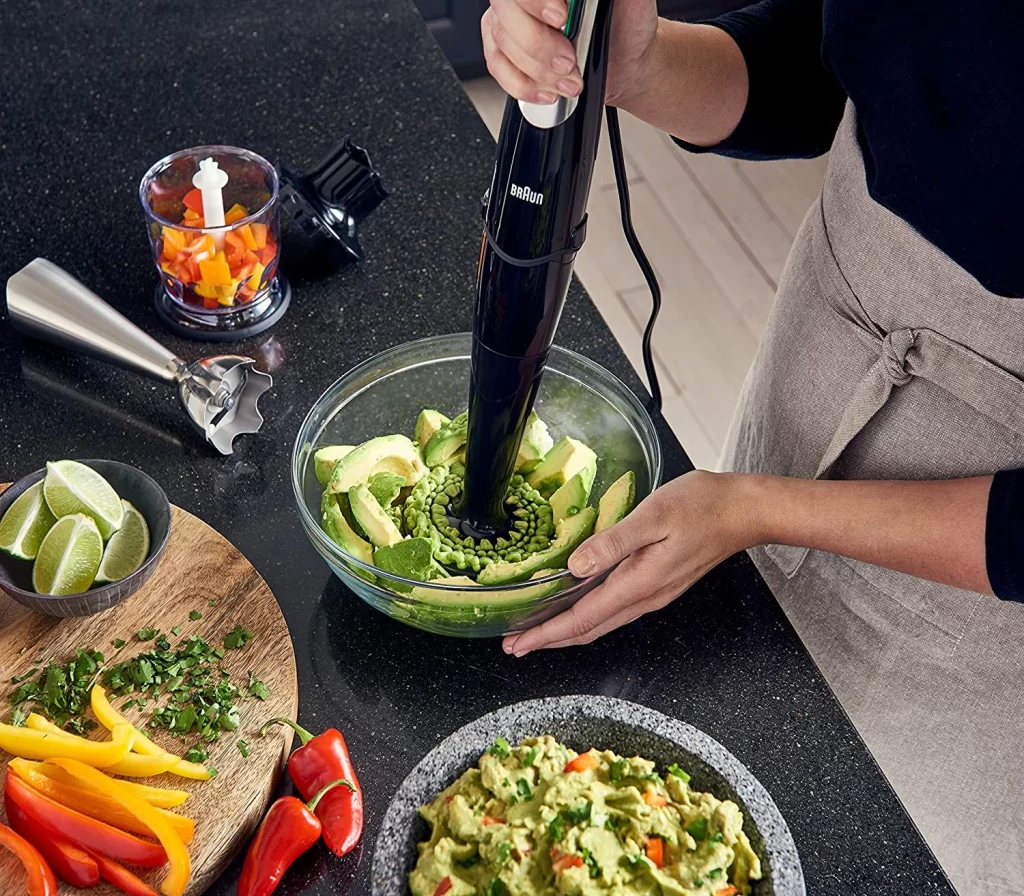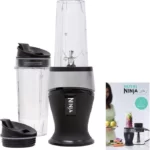One of the most versatile kitchen appliances is the immersion blender. However, the subject of how to use an immersion blender is still a concern. Soups, stews, and smoothies are no problem with this blender. However, there are a plethora of different applications for it.
Whipped cream, for example, may be made using this method. It may also be used to produce emulsions, such as mayonnaise or vinaigrette. When it comes to slicing onions and preparing meringue, the accessories that come with your device may also be helpful.
All of this may seem out of reach until you learn how to utilize an immersion blender. Here, you’ll discover precisely how to operate an immersion blender in our 9-step guide. If you’re interested in cleaning your gadget or using it for a particular purpose, you’ll find information here.
The Basics of Using an Immersion Blender
Let’s go through the fundamentals of using an immersion blender before getting into some of the more advanced techniques. For those who haven’t used one before or wish to brush up on their skills, here is the place to begin!
First and foremost, make sure you’ve read the product’s instructions. Make sure to follow their directions if they say something different from what you’ve read here. Keep a close eye out for these two items when reading the instructions:
- The maximum temperature at which your meal should be served.
- Your device’s ability to operate for a lengthy period without interruption.
Make sure the food you’re going to mix is at the right temperature and in the proper container before you start. There’s a risk of splashing and being burnt if it’s too hot, so it’s essential to keep it at a safe temperature for your safety.
The immersion blender may even melt. The manufacturer’s instructions should have the maximum temperature permitted listed somewhere. If you’re using a blender, you’ll need a container that’s broad enough to accommodate it but not so full that the contents spill over the sides.

Step 1: Determine Which Blades You’d Want to Use and Attach Them.
There are many different attachments and blades available for immersion blenders, so be sure you choose the proper one for the task! The right edge must be attached to the immersion blender before plugging it in for safety reasons. You can’t unintentionally switch on your smartphone while playing with the blades if it’s not connected yet. Cordless immersion blenders also have safety systems in place to prevent this from happening.
Step 2: Connect the Immersion Blender to the Power Source
Use an outlet near enough from the food you’re blending so that the cable doesn’t strain. When using a cordless electric mixer, make sure the battery is fully charged.
Step 3: The Blender Should Now Be Inserted Into the Meal
Under your meal, the whole expanded tip should be. For liquid-heavy blends, such as sauces or soups, this is especially crucial to remember. One of the most common causes of splashes and spills is if the blender is not inserted into the water before it is turned on. Don’t go deeper than the “max” line on the exterior of the blender, which most of them have.
Step 4: Activate the Immersion Blender
When the tip is below the level of the food, you should turn it on. This prevents food from being splattered and sprayed all over the place.
Step 5: Stir the Meal Using the Blender
It’s possible to just move the mixer up and down depending on what you’re preparing and the shape and size of your container. Lifting it too far out of the meal can cause it to spatter. Also, keep an eye on the “max” line; don’t submerge it too deeply.
Additionally, you may tilt it at various angles to draw different pieces of food through and even tilt the container holding the food. To guarantee that all of the food is blended, it’s best to move the mixer and container around.
Step 6: Unplug and Unplug and Unplug the Immersion Blender
This should be done while the food is still at a lower level. The food will be splashed everywhere if you remove the gadget while operating and then turn it off. Because of this, many people believe that these technologies are untidy. This is a typical misunderstanding. You can prevent this problem by shutting it off while it’s still beneath the food.
Step 7: Remove the Mixer from the Food At This Point
Your food won’t spatter since the blender has already been turned off.
Step 8: Remove the Plug from the Gadget and Put It Out Of Its Misery
However, this presupposes you’re using a corded blender, which is not the case if you’re using a cordless one.
Step 9: Remove the Immersion Blender’s Parts and Thoroughly Clean Them
Consult your device’s manufacturer’s instructions for cleaning procedures. To maintain the blades a sharp as possible, we prefer to arm the blender’s bladed section, even if it is dishwasher-safe. There’s a good chance that the top motorized portion of the blender isn’t safe to wash. You may use a warm, moist towel to clean it if required.
Even if I don’t have time to clean my electric mixer right away thoroughly, we prefer to, at minimum, rinse the blades. This removes the bulk of the meal and prevents the hard-to-reach places from becoming persistently full of dry soup or sauce.
How Do You Make Soup With An Immersion Blender?
This method is the one I like, and it’s the one I use most often. In addition to saving money and time, this method also eliminates the need to wash dishes. In addition, it’s considerably more convenient than having to transfer many pots of soup into the standard blender one at a time.
With an immersion blender, these are the fundamentals of how to make soup:
- Maintain a safe and appropriate temperature for the soup, as per the manufacturer’s instructions.
- Attach the blade of your choice to your immersion blender.
- If the cable is long enough, plug the blender into the socket next to your pot of soup.
- Submerge the blender’s blades to the tip of the soup. To avoid damaging the blender, do not immerse it more profound than the “max” line.
- Turn just on blender. There must be no spattered since the bladed section is already submerged in the soup.
- In the saucepan of soup, gently move the blender up, down, and around. Don’t elevate the blades just above the liquid level, although you may tilt the mixer to get better results in select regions of the mixture. Soup pots that are not too heavy may be inclined to help transfer contents into reachable blender locations.
- Turn off the mixer with the blade still immersed whenever the soup is done.
- Remove its blender from the soup and discard the container.
- Remove the blender’s power cord.
Dismantle the blender and wash the bladed area promptly. This prevents the soap from drying on the blades or becoming stuck in hard-to-reach areas.

The Hand Blender And A Blender, What’s The Difference?
Both of these phrases refer to the same product. It’s also known as a blender stick or a blender on a stick. In contrast to a hand mixer, the hand blender has a significant advantage.
The former has been the focus of our discussion up to this point. As an attached piece of machinery, it’s meant for blending, but it may also be used for mixing, whipping, and chopping in addition to.
Unlike a stand mixer, a hand mixer’s primary function is to mix. A whip or beating attachment is more common than a single whipping or beating attachment. When it comes to whipping milk or beating egg whites, you may already be acquainted with this instrument.
If you’re only whipping, beating, or mixing, a handheld mixer may suffice. However, if you want to incorporate, we suggest purchasing a hand blender as well. Even though some attachments on hand blenders may mimic those on hand mixers, a well-stocked kitchen should have both.
How Long Can An Immersion Blender Be Left Running For?
Because no two devices are the same, you’ll want to consult the instructions that came with your device to find out how to use it properly. Immersion blenders typically have a run time of 30 seconds before they need to be put away for a while.
It’s a tiny amount of time, but it’s more than enough for the majority of ordinary blending chores. The time it takes to make a simple pot of soup has decreased dramatically in recent years. This means you shouldn’t be concerned about the possibility of a restriction since it’s likely you won’t be impacted by it.
Is It Possible To Mix With An Immersion Blender?
Unfortunately not or instead, you can do it with a blender with the usual blade attachment, but the results will be less than optimal, and we don’t encourage it. It is ideal to be wholly immersed when using an immersion blender since blending often entails introducing air into the mixture.
Many immersion blenders, on the other hand, come with a variety of accessories. Whisks and beaters are two of the most prevalent. As long as you have the accessories for an immersion blender, you may use it as a mixer. To begin mixing, just connect the appropriate attachment to the mixer and turn it on.
An Immersion Blender’s Cleaning Methods
How to use an immersion blender without making a mess, firstly make sure your blender is disconnected. The blades might be dangerously close to your fingers if you start dismantling them while it’s plugged in.
Use a moist towel to clean the blender’s top, powered section if required. Over and across the bladed section of the bottom part, run hot water. This removes most of the food residue from the blender, making it seem clean and ready to use.
Using a hot soap sponge, thoroughly clean the lowest section of the device, such as the stem, blade, and guard. We hand-dry all edges and let the remainder air-dry on a clean cloth.
Another frequent choice is:
- Add hot, soapy water to a tall container. There is the possibility for spills and splatters, so you’ll want to do it in your sink for this step.
- Add water to the blender if you were making soup. Plugging the blender back in is still recommended.
- Add soapy water to the blender and turn it on. Water will quickly swirl around and clean the blades, guards, and stem as you do so.
- Clean the blender by rinsing it in clean water, then drying the blades by hand.
- The blender must be cleaned immediately after use for these techniques! Just give it a brief rinse, even if it’s not completely clean so that you don’t wind up with dehydrated food all over this one.
- Don’t worry if you forget, however. Rinse the immersion blender’s bottom using hot, soapy water and then proceed with standard cleaning procedures.
There are dishwasher-safe parts in certain immersion blenders. Verify the manufacturer’s instructions to check whether certain pieces may be placed in the dishwasher straightaway. According to the manufacturer, however, I suggest cleaning and drying the blades by hand. They’ll be able to preserve their sharpness longer with this.
Are Immersion Blenders Worth The Money?
It all depends on what you prepare and how you cook it or what do you use an immersion blender for. As a result of their versatility, these appliances are suitable for more than just soups and sauces. The answer is obviously yes for most home chefs. And the more you use it, the more you’ll discover new ways to put it to good use.
When your husband relocated to a new country, these were among the first items we purchased for our new house. When we first moved into our new home, our kitchen was essentially stocked with my collection of beloved knives, a wok, cast iron skillet, a sous vide device and a new plunge blender. One of our kitchen mainstays, we sure it will be for you as well.
If you’re not entirely convinced, you may start with a less expensive alternative. Although it may lack some of the power and longevity of more expensive models, it will help you determine whether or not to invest in one.
Final Verdict
With the help of an immersion blender, you’ll discover a whole new world of culinary possibilities. Having a choice of attachments that allow you to use the blender as a mixer, mixer, whipper, and chopper is even better.
All of the most frequently asked questions concerning how to use an immersion blender for smoothies or how to properly use an immersion blender have been answered in full here, and we’ve also covered the basics of how to use an immersion blender for soup. We’d love to hear from you if you love this review.

![Do Smoothies Lose Nutrients Overnight? Ultimate Guide [2021] Do Smoothies Lose Nutrients Overnight](https://chefbeast.com/wp-content/uploads/2021/04/Do-Smoothies-Lose-Nutrients-Overnight-150x150.jpg)



